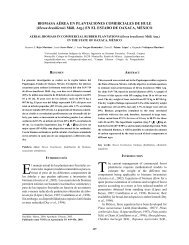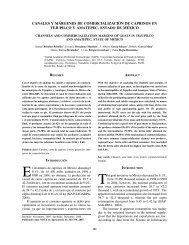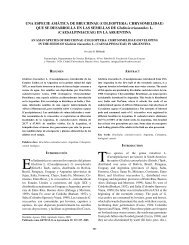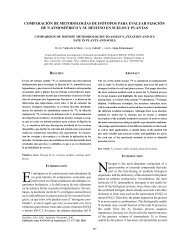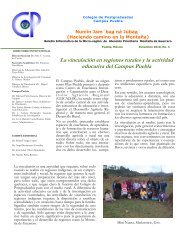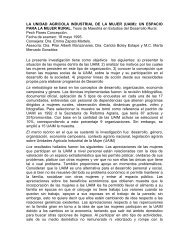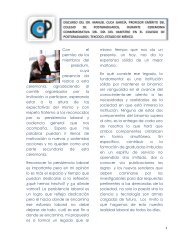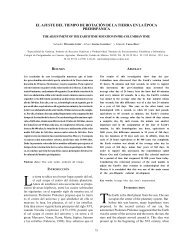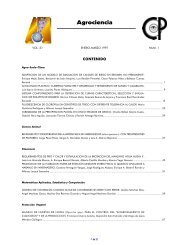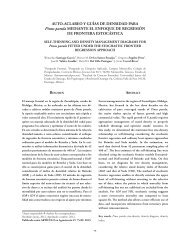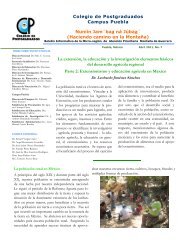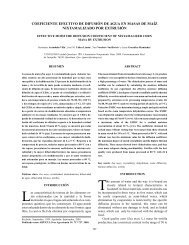04-161 (Regeneración in vitro) - Colegio de Postgraduados
04-161 (Regeneración in vitro) - Colegio de Postgraduados
04-161 (Regeneración in vitro) - Colegio de Postgraduados
Create successful ePaper yourself
Turn your PDF publications into a flip-book with our unique Google optimized e-Paper software.
AGROCIENCIA, NOVIEMBRE-DICIEMBRE 2005<br />
10 mm<br />
Figura 1. <strong>Regeneración</strong> <strong>in</strong> <strong>vitro</strong> <strong>de</strong> plantas <strong>de</strong> cebolla (Allium cepa L.). A: ápices <strong>de</strong> raíz <strong>de</strong>spués <strong>de</strong> cuatro semanas en el medio <strong>de</strong><br />
<strong>in</strong>ducción B. B: callo embriogénico <strong>de</strong>spués <strong>de</strong> ocho semanas <strong>de</strong> cultivo en el medio B. C: plantas regeneradas <strong>de</strong>spués <strong>de</strong> 16<br />
semanas <strong>de</strong> <strong>in</strong>iciar el cultivo. D: formación <strong>de</strong> microbulbos en las plantas regeneradas <strong>in</strong> <strong>vitro</strong>. E: bulbo <strong>de</strong>spués <strong>de</strong> 12 semanas<br />
<strong>de</strong> estar creciendo en <strong>in</strong>verna<strong>de</strong>ro. F: plantas obtenidas a partir <strong>de</strong> bulbos obtenidos en el <strong>in</strong>verna<strong>de</strong>ro.<br />
Figure 1. In <strong>vitro</strong> regeneration of onion plants (Allium cepa L.), A: root tips after four weeks <strong>in</strong> <strong>in</strong>duction medium B. B: embryogenic<br />
callus after eight weeks of culture <strong>in</strong> medium B. C: regenerated plants after 16 weeks of <strong>in</strong>itiat<strong>in</strong>g the culture. D: microbulb<br />
formation <strong>in</strong> plants regenerated <strong>in</strong> <strong>vitro</strong>. E: bulb after 12 weeks grow<strong>in</strong>g <strong>in</strong> greenhouse. F: plants obta<strong>in</strong>ed from bulbs produced<br />
<strong>in</strong> greenhouse.<br />
Se obtuvieron callos embriogénicos (Figura 1B) tanto<br />
en presencia únicamente <strong>de</strong> 2, 4-D y en comb<strong>in</strong>ación<br />
con c<strong>in</strong>et<strong>in</strong>a. S<strong>in</strong> embargo, la formación <strong>de</strong> plantas a partir<br />
<strong>de</strong> estos callos fue numéricamente menor cuando los<br />
callos embriogénicos fueron <strong>in</strong>ducidos en los medios que<br />
contenían 2, 4-D y c<strong>in</strong>et<strong>in</strong>a (Cuadro 3). Estos resultados<br />
contrastan con lo reportado por Robledo-Paz et al. (2000)<br />
y Van <strong>de</strong>r Valk et al. (1992) para tejidos <strong>de</strong> ajo y cebolla,<br />
pero concuerdan con lo observado en cultivos<br />
embriogénicos <strong>de</strong> cacahuate (Arachis hypogaea L.)<br />
(Baker y Wetzste<strong>in</strong>, 1994) y chile (Capsicum annuum<br />
L.) (Ste<strong>in</strong>itz et al., 2003). La poca <strong>in</strong>fluencia <strong>de</strong> la c<strong>in</strong>et<strong>in</strong>a<br />
en la regeneración <strong>de</strong> plantas <strong>de</strong> cebolla podría <strong>de</strong>berse a<br />
que los niveles usados <strong>de</strong> este fitorregulador fueron mayores<br />
o menores que las concentraciones requeridas para<br />
652 VOLUMEN 39, NÚMERO 6<br />
A B C<br />
1 mm<br />
E<br />
1 mm<br />
10 cm<br />
et al., 2000),which would be corroborated by the results<br />
of the present study.<br />
The morphogenic response of the explants began with<br />
an <strong>in</strong>crement of up to five times their size after 30 d of<br />
culture <strong>in</strong> the medium of <strong>in</strong>duction. Cellular proliferation<br />
was <strong>de</strong>tected at specific sites, be<strong>in</strong>g concentrated <strong>in</strong><br />
meristematic zones of the explant (Figure 1A). Haque et<br />
al. (1997) and Robledo-Paz et al. (2000) also observed<br />
callus formation only <strong>in</strong> the meristematic zone of the root<br />
tip. The calluses, produced after eight weeks, were of<br />
two types, one, light yellow, compact, and translucent,<br />
and the other, of <strong>in</strong>tense yellow color, opaque, easily be<strong>in</strong>g<br />
dis<strong>in</strong>tegrated (friable); <strong>in</strong> other words, with characteristics<br />
similar to those reported by Van <strong>de</strong>r Valk et al. (1992)<br />
and Zheng et al. (1998) for Allium cepa. Furthermore,<br />
F<br />
10 mm<br />
5 mm<br />
D



